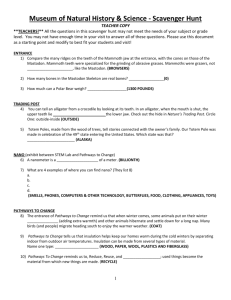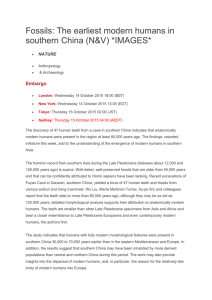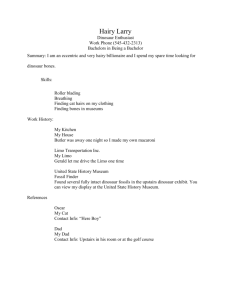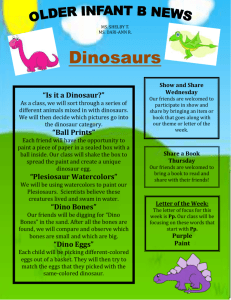Museum of Natural History and Science Scavenger Hunt
advertisement
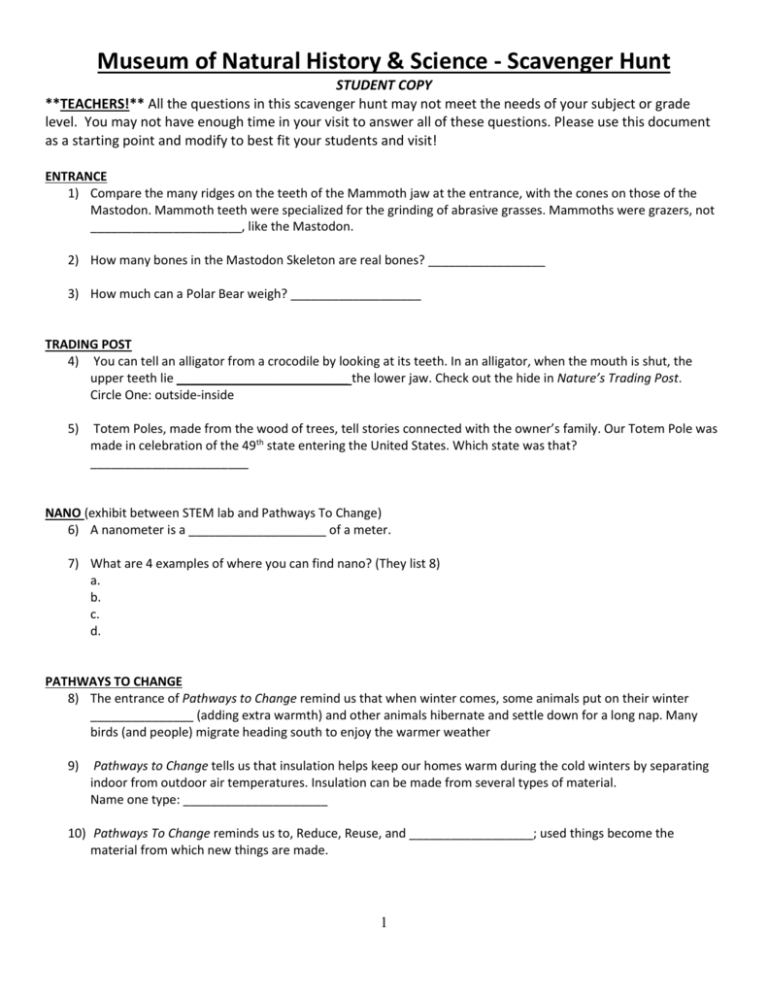
Museum of Natural History & Science - Scavenger Hunt STUDENT COPY **TEACHERS!** All the questions in this scavenger hunt may not meet the needs of your subject or grade level. You may not have enough time in your visit to answer all of these questions. Please use this document as a starting point and modify to best fit your students and visit! ENTRANCE 1) Compare the many ridges on the teeth of the Mammoth jaw at the entrance, with the cones on those of the Mastodon. Mammoth teeth were specialized for the grinding of abrasive grasses. Mammoths were grazers, not ______________________, like the Mastodon. 2) How many bones in the Mastodon Skeleton are real bones? _________________ 3) How much can a Polar Bear weigh? ___________________ TRADING POST 4) You can tell an alligator from a crocodile by looking at its teeth. In an alligator, when the mouth is shut, the upper teeth lie _________________________ the lower jaw. Check out the hide in Nature’s Trading Post. Circle One: outside-inside 5) Totem Poles, made from the wood of trees, tell stories connected with the owner’s family. Our Totem Pole was made in celebration of the 49th state entering the United States. Which state was that? _______________________ NANO (exhibit between STEM lab and Pathways To Change) 6) A nanometer is a ____________________ of a meter. 7) What are 4 examples of where you can find nano? (They list 8) a. b. c. d. PATHWAYS TO CHANGE 8) The entrance of Pathways to Change remind us that when winter comes, some animals put on their winter _______________ (adding extra warmth) and other animals hibernate and settle down for a long nap. Many birds (and people) migrate heading south to enjoy the warmer weather 9) Pathways to Change tells us that insulation helps keep our homes warm during the cold winters by separating indoor from outdoor air temperatures. Insulation can be made from several types of material. Name one type: _____________________ 10) Pathways To Change reminds us to, Reduce, Reuse, and __________________; used things become the material from which new things are made. 1 EARTH STORIES AND EARTH WORKS 11) The ______________________ Owl found in the Earth Stories exhibit is a rare winter visitor to the Greater Cincinnati area from the far north. It is active during the day and when present, is often found near airports. 12) The spear points, in the case right before the Space exhibit, is from what time period?_____________________ SPACE 13) The Asteroid Belt located in our solar system is between ____________________ and ___________________. 14) What’s the difference between a meteoroid and meteorite? __________________________________ ___________________________________________________________________________________________ __________________________________________________________________________________________ 15) Each “Ambassador of Exploration” was presented a lunar sample (moon rock) to be displayed at a museum or educational institution of their choice. CMC is honored to be the site chosen by ___________________________________ for the display of his lunar sample. ROCKS AND MINERALS 16) What are some properties of copper? ____________________________________________________________ ___________________________________________________________________________________________ 17) Dubbed by visitors as the “peace” or “bunny ear” crystal, our ___________________ is the purple variety of quartz created by slowly deposited solutions flowing through ancient volcanic rock and can be seen near the Cave. CAVES (Don’t forget to look for answers in the hallway when you exit the cave) 18) The mummified remains of humans and animals are often preserved in caves due to the extreme cold and dry or damp environmental conditions. The Cave hallway explains that ______________ are a type of cave animal that fall in, wash in, or wander in by accident into caves. Some find their way out, others die---increasing the chance of mummification. 19) Bats are the only ___________________ that can fly. 20) Bats are “cave guests” or __________________. This means they spend part of their life in caves, but must leave to find food to eat. 21) All bats live in caves. Circle one: True – False 22) What is the name of the caver that was trapped in Sand Cave? __________________ THE SCIENCE OF MUMMIES 23) Given the name ________, the African boy name meaning “life,” our very own mummy came to CMC in September 2009 as a gift from the Cincinnati Art Museum. 2 24) Umi, the mummy displayed in the Science of Mummies exhibit, is a very special mummy due to what additive technology that was used to create a physical, 3-deminsional replica of Umi’s body? _______________________________ 25) One of the amulets buried with Umi, our mummy in the Science of Mummies exhibit, is shaped in the form of a _____________________ beetle an important part of ancient Egyptian culture. ICE AGE (UPPER) 26) What are the four chapters of the extinction process? (Hint: Sherlock Holmes might give you a hint) a. b. c. d. 27) According to the Upper Ice Age exhibit, the Giant Beaver’s teeth were more suited for clipping small _________________________rather than chiseling trees to build giant dams. 28) The “Stories told by Bones” section of the Upper Ice Age exhibit tells us what a tooth is made of: Enamel, dentine and _____________________; a substance found on the teeth of grazing animals. 29) In the “Stories Told by Bones” section of Upper Ice age, we learn that the size and shape of an animal’s limb bones tell how they were used. Notice the massive leg bone and block-like wrist bone of the _____________________. The limb’s main function was not running, but bearing weight. 30) There are many causes of extinction, and humans are one of them. The “Bodies Vanish” section explains how commercial hunting and habitat destruction brought passenger pigeons to the brink of extinction with the last one dying in Cincinnati in ________. GLACIAL GEOLOGY HALL (this exhibit starts at the first “ice cave” and ends at the second “ice cave”) 31) What percentage of the world’s ice does Antarctica have? _________________ 32) What is the scientific name for rocks that hitched a ride from Canada on a glacier? ____________ 33) What year does the top layer of the Ice Core Correspond to? _______________ 34) For thousands of years, trees have provided oxygen to help us breathe. Our Redwood tree ring, displayed in the Glacial Geology Hall, provided oxygen for many years before it was cut down in what year? _________________ 35) How old was the Redwood when it was cut down? (Exact answer! Use your answer from the previous questions to help!) ________________________ 36) Trees are some of nature’s most accurate record keepers. After coring a sample, scientists can measure climatic change by looking at the rings of the tree. Exploring the Glacial Geology Hall, name one other piece of evidence that scientists have found by looking at core samples. _______________________________________________ 3 37) Human activity increasingly releases gases into the atmosphere that continually build up there. According to the Glacial Geology Hall, with a tremendous increase in a gas called carbon_________________________, scientists believe it is canceling out the effects of the Earth’s tilt and wobble causing the Earth to warm up. 38) Where is the ice cave that ours is modeled after? ___________________________________________________ LOWER ICE AGE TRAIL 39) Our very own Ice Age Trail is a great place to hike and see all kinds of animals. Like the __________ wolf! Did you know that they aren’t direct ancestors of modern wolves, and they were well adapted to the cold Ice Age? 40) What kind of bear, located in the painting, is behind the giant beaver? __________________________________ CINCINNATI UNDER THE SEA 41) Today we would describe Cincinnati as being a Temperate Deciduous Forest biome. About 450 million years ago what type of biome would best describe Cincinnati?________________ 42) What is the official state invertebrate fossil of Ohio? _________________________________________________ EXTINCTIONS THROUGH TIME 43) There have been 5 great mass extinctions caused by natural climate shifts, oceanic changes, volcanism and extraterrestrial impacts. Scientists believe the sixth mass extinction will be caused by ___________________________________________________. 44) Looking at the “On the Brink” display case, name 5 organisms listed as being threatened and/or endangered. a. b. c. d. e. CREATURES OF ANCIENT SEAS / ANCIENT MARINE LIFE 45) Which extinct bony fish found in the Creatures of Ancient Seas exhibit, is tarpon-like in appearance and have been found with other large fish contained in its stomach? __________________________________________ 46) The jaws of what large fish, displayed in the Creatures of Ancient Seas Exhibit did not hold true teeth, but were bony plates that formed sharp cutting edges? ____________________________________________________ 47) What giant marine lizard found in the Creatures of Ancient Seas exhibit, was a contemporary of the Cretaceous dinosaurs? (Hint: They were remarkable for having an extra joint in the middle of their jaws.) ______________________________ 4 DINO HALL 48) This extremely rare fossil is one of the earliest known birds, _________________________ sanctus. The finegrained rock on display preserves not only the bones of the skeleton, but the primary flight feathers, body plumage, and horny sheaths of the talons. 49) Bats are the only mammal that can fly. Three vertebrate groups that have independently evolved the ability to fly are birds, bats, and this flying reptile: _________________________________________________________ (Hint: Find Dino Hall and look up!) 50) In order to be light enough to fly, the bones of what giant flying reptile, seen in the Dinosaur Hall, were hollow and paper thin to fly easier and reduce its density? _______________________ 51) The Dinosaur Hall reminds us that scientists believe that the grooves of the ______________________ dinosaur had back plates that contained blood vessels. When blood circulated through them, they were heated by the sun and channeled to the rest of the body to help maintain this dinosaur’s body temperature. 52) Formerly the “Brontosaurus,” our ________________________ skull is one of only 3 in existence and the only one to have been found associated with the cervical or neck vertebrae. 53) No living reptile chews its food. However this type of herbivorous hadrosaurs dinosaur, mentioned in the Dinosaur Hall, had a mouth containing thousands of grinding teeth._____________________________________ 54) What are the names of the skulls on the wall? f. g. h. i. j. 55) Over time, trees become “petrified” and all the organic material turns into fossil. Our “fossil log” located in the Dinosaur Hall is from an extinct tree related to a Norfolk Island pine. Its’ organic material has been replaced with _______________. WORLDS WITHIN OUR YARDS / YARDS 56) The “What You Want…and What to Look Out For” sign help define what a “pest” is. Pests aren’t inherently badthey are just behaving the way they have evolved over time to survive. One example of an insect pest is the ____________________________________________________________- an Asian immigrant killing ash trees and are a major concern to the health of forests. 57) Ecology deals with the interactions among living things and their environments. What is one of the example interactions the “What Goes on in Your Yard” sign describes? (There are 3 given) ___________________________________________________________________________________________ 5 Orientation Map of the Museum of Natural History & Science STEM Lab Worlds Within Our Yards entrance Creatures of Ancient Seas Cincinnati Under the Sea Extinctions Through Time 6
